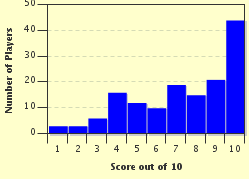Quiz Answer Key and Fun Facts
1. Mauritius is an island nation located around 2,000 kilometres (1,200 miles) from the African mainland. In what body of water would you have to look in order to find it?
2. In 1965, prior to Mauritian independence from the UK, an archipelago of around 60 islands was transferred from Mauritian territory to form the new British Indian Ocean Territory. What is the name of this archipelago, whose sovereignty caused significant disputes between Mauritius and the UK?
3. Mauritius became a founding member of which of these international organisations in 1970?
4. Mauritius Island accounts for the majority of the land area of the nation of Mauritius. What is the name of country's second largest island, located about 550 kilometres (350 miles) east of its larger neighbour?
5. Trou aux Cerfs is one of the most distinctive geological features of Mauritius. What is it?
6. Mauritius is famous for having been the home of the dodo, the ubiquitous symbol of extinction. However, other birds endemic to the country survived into the 21st century. Which of these is one of them?
7. The capital city of Mauritius is the country's major port and centre for trade as well as housing the seat of government. For which 18th century European monarch was the city named?
8. Since the 1960s, the economy of Mauritius has developed away from a reliance on agriculture to include tourism, financial services, renewable energy and other service sector industries. However, which agricultural product remained a key export into the 21st century?
9. Which of these is a popular style of music in Mauritius that is usually sung in Mauritian Creole?
10. The south-western section of the main island of Mauritius is home to a national park that contains the majority of the country's rainforest. What is it called?
Source: Author
Fifiona81
This quiz was reviewed by FunTrivia editor
agony before going online.
Any errors found in FunTrivia content are routinely corrected through our feedback system.
